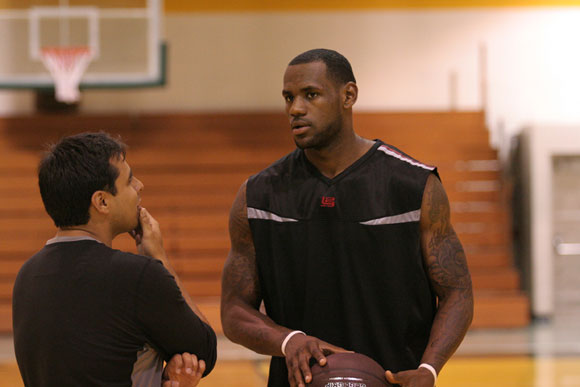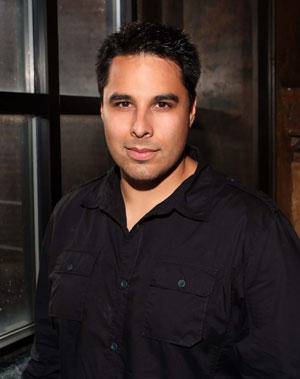Kristopher Belman: More Than A Game

Writer/Director Kristopher Belman began filming More Than A Game while a student at Loyola-Marymount University. Originally a short film project, he acquired financing and distribution for theatrical release. The film premiered at the Toronto International Film Festival in September of 2008.
Rubin Safaya: You studied film at Loyola?
Kristopher Belman: Yeah. Actually I studied television production. It was in the film school. It was my first semester there when I… kind of… or my second semester when I started following these guys.
RS: When you were deciding a concept for the 10-minute class project, what other subjects came to mind? What made you pick this over others?
KB: Well I knew I wanted to do something from Akron, because I was born and raised in Akron, Ohio, which is where the story took place, and I just recently moved to Los Angeles. So I was actually getting a lot of flak from being from Ohio. A lot of my new friends and classmates were like, “We’ve never heard of Akron. We don’t know anything about Ohio.”
They assumed that I was a farm boy and— I’ve actually never been on a farm. But, I was determined do something from my hometown. At that point there weren’t a ton of options. There’s Goodyear, Firestone, the tire industry that’s not really based there any more… That’s kind of where it was at one point.
I’d read an article about these boys. They were phenomenal basketball players. I recognized that could be something interesting. But, you know, in a story you need subtext. You need things that are deeper than just surface-level. One of the articles I read had mentioned that four of these players had played together since fourth grade. In eighth grade they actually made a pact that they were going to go to high school [together] no matter what.
These are four African-American kids from the inner city. They end up going to a predominantly white, private school, and that’s kind of a unique decision. It’s not an obvious one by any means. I read further that that was pretty much the only choice they had if they wanted to keep playing together. That really stuck in my mind.
When I started thinking about Akron that came to my mind because, not only did I think about… what they were doing on the court, but that kind of decision, that shows a sophistication… That shows an emphasis on friendship a lot of people in their thirties and forties don’t have. When you have a more reflective look on life— you know, these kids are twelve years old. They put that much value on friendship. I thought there was something really important there, and I wasn’t sure what it would be. But at that time I only had to do a ten minute project and I’d figure it out when I got there.
RS: At what point did you realize this was developing into more than a ten-minute school project?
KB: There’s kind of two answers to that, I suppose. That first practice I had with those boys, I was really blown away by them as characters, as people. The things they were doing on the court were phenomenal, obviously, and I saw first-hand basketball I’d never seen before at that age. They were so comfortable around each other. You could tell just by sitting with them. Even for like five or ten minutes, you know, of walking into the room… You knew these guys have known each other their whole lives. They were finishing each others’ jokes. They were referencing things— stories from years ago. There was just such a familiarity, it really blew me away.
So, I right away knew, “I feel like this is bigger than ten minutes. I don’t know what it is but I know it’s better than ten minutes.”
That’s why I came back to practice that next day. I was only given permission to come to the one practice, but I decided to show up again and no one said anything. I kept following them. I was really drawn to them as characters.
As the senior season progressed, I think it was the evolution of Coach Dru who— I originally pitched the five friends as the story, and as the season progressed, Coach Dru was just rising and evolving as the central figure of the film. That caught me by surprise. I didn’t expect that going in. It was one of those unplanned miracles of sorts.
Coach Dru, because he has the life perspective and he speaks with such gravity… I [thought] Coach Dru could be the glue to hold this film together. Toward the end of the Senior season, where they were going through all these adverse situations, I saw Coach Dru as this father figure first, then coach.
RS: How did the timeline unfold from getting the initial support for a film crew to getting financing and distribution, before and after the Toronto International Film Festival?
KB: For the first five-and-a-half years it was pretty much myself—me and a camera. I did have— maybe, two or three times I would fly out one of my friends from L.A., one of my classmates, to do some camera work for me if I was doing questions or things like that. After that portion ended, I really knew… I always knew at some point I was going to need financing. I was acquiring archive footage. I was starting to gather songs I knew I wanted to use… from the boys’ time period. Visual effects, original music… Those were things I had planned, but had put off while I was figuring out the story. [It] turned out to be a two-year journey—meetings with financiers and producers, things like that—in which I had a three-minute trailer and an eighteen-page outline. They all yielded the same result, which was, “Hey, we’d love to buy the footage off you… We’d love to hire to direct the LeBron portion of the film.”

They weren’t interested in the [other] stories at all. I was only interested in the team… Lebron, to me— that’s just not a feature length film. It’s the easy choice.
Finally, when I was able to get that financing, after about two years of meetings, and I partnered up with Harvey Mason, Jr., as a producer… He was the one that saw what I was trying to do. I think it was because he wasn’t in the film world that he took that chance. He’s a music producer. He wanted to roll that die, I guess. That’s when I was able to take a crew back and do these reshoot interviews, and hire a visual effects artist.
That was all pre-Toronto. We premiered [the film] at Toronto last September. We didn’t change the film from Toronto to last night. I can’t say that. We swapped end-title songs. We got this song from Mary J. Blige… other than that, the film didn’t change…
RS: You were pretty firm on preserving the film as you had it…
KB: Yeah.
RS: In the process of filtering the film down to a cogent narrative, what difficult decisions did you have to make—sequences you had to leave out for flow—which you wish you hadn’t had to cut?
KB: Corey Jones was a player. You see him on the court a lot. He was the one who started in front of Willie [McGee] that Senior year. That decision to start Corey over Willie was a pretty big part of Willie’s back story. It certainly was a big part of the team dynamic. Unfortunately it wasn’t possible to work Corey into the film. We tried several ways of integrating his story, but it really bogged down the narrative. I really credit Scott [Balcerek] with forcing me to make judicious decisions. Scott was my editor. He has experience in not just documentary but narrative feature. He’s worked on high-budget and low-budget. He’s got a wealth of knowledge and we collaborated a lot. We tried using parts of Corey to explain him a little bit and give him a little bit of life, but at the end of the day we decided if a particular character or story beat doesn’t drive forward the other characters or the main story—this quest for championship—then we had to cut it loose.
The reality is, as important as Corey was to the team, he wasn’t really a part of their story off the court. That doesn’t take away anything he did for the team. But, if it was a perfect world, it would have been nice to give him a little bit more credit.
RS: The film doesn’t focus on race much, except for the decision to go to St. Vincent’s. Did you set out before-hand to make this about something other than race, or did the footage dictate that?
KB: There are areas where faith is explored. There are areas where race is explored lightly. There’s some of the controversies we go into with LeBron. At the end of the day, every decision that was made, whether it be from the aesthetics, whether it be from how we did the visual effects or how we chose to edit or score the film, it was always from, “How do we make sure this can reach a broad audience and not just be for documentary fans, not just be for sports fans?”
I felt there were themes in here that everyone could relate to, even if they’re not basketball fans. I thought these messages were important, but I’m always a fan when messages are in film and they’re subtle. You can see them, and interpret them… but you don’t have to hit people over the head with them. I felt like, with race… that was a conscious decision early on. Even as early as freshman year… they felt accepted. While there weren’t a lot of black kids at the school, at that point that didn’t matter. We kind of shed that color cape right there. They felt like they were equal. They felt like they belonged. It didn’t make sense to go into it any more. I thought that was important. That was a… revelation that LeBron himself said. Sian [Cotton] said, “The African-American community looked at us like we were traitors.”
RS: When you were bringing this story together, what documentaries, films or other literature provided guidance or inspiration?
KB: Films that inspired? Murderball. It’s about sports but has so much subtext. I can’t tell you how many times I watched that. Spellbound… Go Tigers… There’s a narrative film, City of God. The way they introduce characters. I was blown away by that. You’d meet a character. They’d go into his backstory. It was like… [in] a minute and a half you learned everything that was pertinent to understanding how that character related to the story. The filmmakers seamlessly went back into that main story. That’s really how we approached these backstories. When we sat down, me and Brad Hogan (the co-writer), we drew out this eighteen-page outline… We watched City of God three or four times and said, “How do we make sure these characters are introduced in points that have specific A-story anchors? How can we seamlessly insert them back in?”
RS: When you started this did you have any idea that where these kids would go?
KB: I knew they’re special and that they’d find success. I didn’t know LeBron would be last years MVP. Willie’s getting his master’s [degree] now. They’re all special kids and they have a great foundation in their friendship. There’s no doubt in my mind that they’re all going to be very successful. They’re always going to be friends. I’ll say that without a shadow of a doubt.
Rubin Safaya’s review of More Than A Game can be read here.